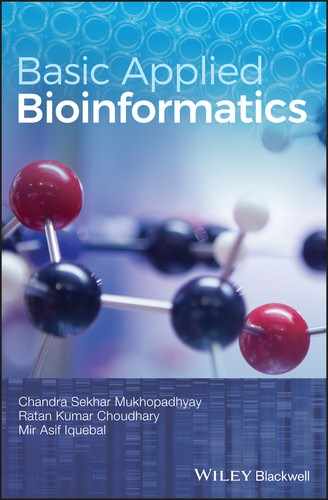Appendix F: Evolutionary Models of Molecular Phylogeny
CS Mukhopadhyay and RK Choudhary
School of Animal Biotechnology, GADVASU, Ludhiana
INTRODUCTION
Studies of molecular evolution and construction of phylogenetic trees are based on mathematical models that underpin the process of nucleotide substitution causing the process of speciation. A number of models have been hypothesized, based on certain assumptions of evolution. Some of the important models are described in this chapter.
Jukes–Cantor Model (1969) or JC69
This is the simplest DNA substitution model, which assumes equal base frequencies and a constant rate of evolution with a base substitution rate (Figure F1) of “α”. The transition (Purine to Purine and Pyrimidine to Pyrimidine) frequency is assumed to be same as the transversion (Purine to Pyrimidine and vice versa) frequency; hence, the model has a single parameter “α”. A substitution matrix (Figure F2) is generated for all possible base substitutions, assuming a fixed rate of changeover.

FIGURE F1 Substitution of nucleotides leading to transition and transversion.

FIGURE F2 Jukes–Cantor one‐parameter substitution model
(Jukes and Cantor, 1969).
The substitution matrix is generated from a constant rate of base substitution per unit time, based on the JC69 model.

FIGURE F3 Rates of transition and transversion are the same (α).
The substitution matrix generated from a constant rate of base substitution for a specific time period (ζ), based on the JC69 model, is shown in Figure F4.

FIGURE F4 Amount of base‐substitution in a period of time “ζ” and equal rates of transition and transversion (α).
The amount of base substitution can be calculated, considering a stipulated lapse of time (ζ) from initiation of the evolutionary event in the study.
Mathematically, the amount of base substitution can be reduced to:
Branch length (for substitution of a base by the same base itself):=

Branch length (for substitution of a base by any base other than itself):

Estimate of evolutionary distance (d) = (–3/4 ln(1–4/3p)) where p is the p‐distance that estimates the proportion of sites that differ between two sequences under study.
The JC69 model is applicable under simple conditions, but is not at all suitable for a complex evolutionary model.
Kimura’s Two‐Parameter Model (1980) or K80 model
The K80 model is an extension of JC69. The model assumes different rates of transitions (α) and transversions (β).
Let:
- α = probability of substitution due to a transition at time “t”
- β = probability of substitution due to a transversion at time “t”
The substitution matrix at unit time (t = 1) will be as follows:

FIGURE F5 K80 model: amount of base‐substitution in unit time period (t = 1), assuming different rates of transition (α) and transversion (β).
The rate of substitution can be approximated to the following:
- Branch length for transversion (other than itself) =

- Branch length for transition (other than itself) =

- Branch length for substitution of a base by the same base itself = Θ(ζ) = 1–2 ψ(ζ) – ϕ(ζ).
The distance obtained from the Kimura 2 parameter model is:

where:
- p = proportion of sites undergoing transition;
- q = proportion of sites undergoing transversion
Felenstein model (1981) or F81 model
The JC69 model assumes an equal rate of substitution among all nucleotide residues, which does not hold good for several practical and complex DNA evolution models. The F81 model modifies this assumption with unequal substitution frequencies for different bases. Thus, the substitution rate matrix has four different proportions for the four common bases:

FIGURE F6 F81 model: rate of base‐substitution is different for four bases: adenine (ρA), guanine (ρG), cytosine (ρC) and thymine (ρT).
The expected number of substitutions per site  .
.
The other models that have been developed to study DNA evolution are Hasegawa et al. (1985), Tamura (1992), Tamura and Nei (1993), the generalized time reversible model, etc. The scope of this chapter is too limited to discuss the models in length and breadth.
